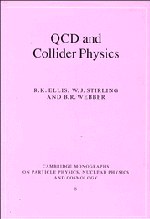Book contents
- Frontmatter
- Contents
- Preface
- 1 Fundamentals of QCD
- 2 Asymptotic freedom and confinement
- 3 QCD in electron-positron annihilation
- 4 Deep inelastic scattering
- 5 Parton branching and jet simulation
- 6 Jet properties beyond fixed order
- 7 Hadroproduction of jets and photons
- 8 Electroweak interactions
- 9 The production of vector bosons
- 10 Heavy quarks
- 11 Higgs bosons at high-energy colliders
- 12 Measurements of the strong coupling constant
- Index
Preface
Published online by Cambridge University Press: 05 May 2010
- Frontmatter
- Contents
- Preface
- 1 Fundamentals of QCD
- 2 Asymptotic freedom and confinement
- 3 QCD in electron-positron annihilation
- 4 Deep inelastic scattering
- 5 Parton branching and jet simulation
- 6 Jet properties beyond fixed order
- 7 Hadroproduction of jets and photons
- 8 Electroweak interactions
- 9 The production of vector bosons
- 10 Heavy quarks
- 11 Higgs bosons at high-energy colliders
- 12 Measurements of the strong coupling constant
- Index
Summary
Quantum Chromodynamics (QCD) is the theory of the strong interaction, one of the four fundamental forces in nature. It describes the interactions between quarks and gluons, and in particular how they bind together to form the class of particles called hadrons, of which the proton and neutron are familiar examples. QCD emerged as a mathematically consistent theory in the 1970s, and nowadays is regarded as one of the cornerstones of the ‘Standard Model’ of the elementary particles and their interactions.
Collider physics has grown from a small part of the subject in the 1960s to the position it now holds as the principal method of high-energy physics research. Particle colliders provide the highest available centre-of-mass energies and permit us to probe the structure of matter at the shortest distances. On these scales, all of the known fundamental interactions except gravity can be studied in unprecedented detail. In this book, in order to limit the scope, and not stray too far from our field of expertise, we concentrate mainly on the strong interaction aspects of collider physics, which are described by QCD.
One of the triumphs of modern particle physics has been the extent to which QCD has successfully accounted for the strong interaction processes observed at colliders, most notably the dramatic phenomena of hadronic jet and heavy quark production. Our aim here is to show what has been achieved in this area, while indicating the directions that need further development. Increasingly the study of QCD also has an ‘engineering’ aspect. In order to exploit the potential of high-energy colliders to study other physics, especially at machines with circulating hadron beams, one needs a quantitative understanding of QCD.
- Type
- Chapter
- Information
- QCD and Collider Physics , pp. xii - xivPublisher: Cambridge University PressPrint publication year: 1996



